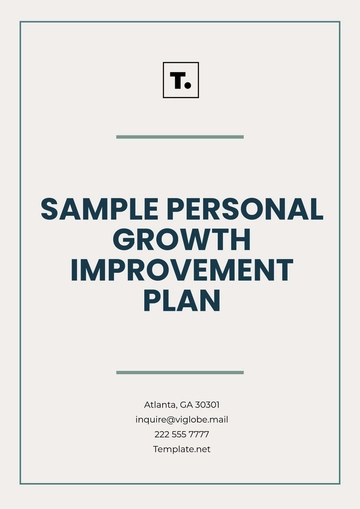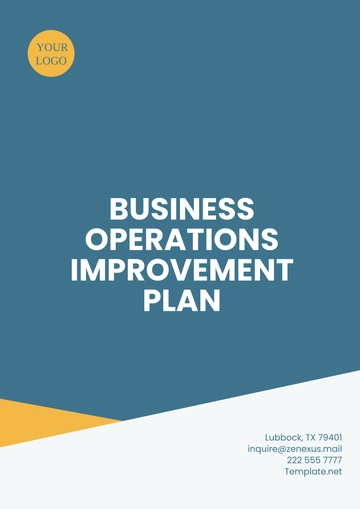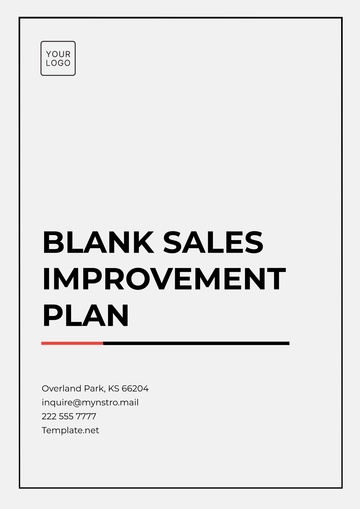Free Product Quality Improvement Plan

Prepared by:
[YOUR NAME]
[YOUR COMPANY NAME]
Introduction
This Product Quality Improvement Plan (PQIP) is designed to enhance the quality of our product by addressing identified weaknesses and implementing a series of improvements across various stages of the product lifecycle. The plan provides a structured approach to ensure that the product meets or exceeds customer expectations, adheres to quality standards, and remains competitive in the market.
Objectives
The primary objectives of this Product Quality Improvement Plan are:
To reduce defects and quality issues in the product.
To enhance the product’s performance and functionality.
To increase customer satisfaction through consistent product quality.
To align the product with industry standards and regulations.
Scope
This plan applies to all stages of the product development process, from design to post-launch evaluation. It covers product quality across manufacturing, customer feedback, regulatory compliance, and ongoing product updates.
Current Situation
Based on recent customer feedback, quality audits, and product performance data, several key areas have been identified for improvement:
Defects in Product Durability: A percentage of products have shown signs of wear and tear sooner than expected.
Customer Complaints: Complaints about specific features not meeting expectations.
Production Inefficiencies: Quality control during the manufacturing process has been inconsistent, leading to a higher defect rate.
Improvement Strategy
1. Root Cause Analysis
Conduct a thorough analysis of the identified issues to determine the underlying causes. This includes reviewing production processes, materials used, design flaws, and customer feedback patterns. The key areas of focus will include:
Product materials and components.
Manufacturing process inconsistencies.
Design specifications and their impact on product longevity.
2. Enhancement of Design
Work with the design team to improve product features that have caused complaints or have failed to meet customer expectations. This may involve:
Redesigning components to increase durability.
Simplifying complex features to improve user experience.
Incorporating feedback from customer surveys to make targeted enhancements.
3. Process Optimization
Revise manufacturing processes to ensure higher consistency and precision:
Implementation of Six Sigma Methodology: Introduce Six Sigma to reduce defects and ensure uniformity in production.
Improved Quality Control: Strengthen quality assurance checks at each stage of production, with increased focus on final product inspection.
Supplier Audits: Ensure that raw materials and components meet the highest quality standards.
4. Training and Development
Offer additional training to all employees involved in the production and quality assurance processes:
Provide workshops on best practices in quality management.
Train employees to identify and address quality issues early in the production process.
Encourage a culture of quality by rewarding employees for contributing to quality improvement initiatives.
5. Customer Feedback Loop
Enhance the collection and analysis of customer feedback:
Implement surveys, focus groups, and customer satisfaction tools to gather detailed input from customers.
Set up a dedicated team to analyze customer feedback regularly and prioritize issues based on impact.
Establish a system to monitor the effectiveness of quality improvements through ongoing customer satisfaction metrics.
6. Regulatory Compliance and Standards Adherence
Ensure the product complies with all applicable regulations and industry standards:
Review and update product specifications to meet regulatory requirements.
Conduct regular compliance audits to identify potential risks.
Work with legal and compliance teams to ensure that all certifications and approvals are in place.
Timeline
Phase | Action | Timeline | Responsible Party |
|---|---|---|---|
Phase 1 | Root cause analysis | Week 1-2 | Product Development Team |
Phase 2 | Revise design | Week 3-4 | Design & Engineering Teams |
Phase 3 | Optimize manufacturing & implement Six Sigma | Week 4-6 | Production & QA Teams |
Phase 4 | Employee training | Week 5-6 | HR & Training Department |
Phase 5 | Implement a customer feedback system | Week 7-8 | Customer Support & Marketing |
Phase 6 | Final testing & regulatory review | Week 9-10 | QA & Compliance Teams |
Resources Required
Personnel: Dedicated teams from design, engineering, manufacturing, and quality assurance departments.
Technology: Tools for data collection, customer feedback analysis, and process optimization software.
Budget: Funding for materials, training, and any additional equipment needed to improve the production process.
Key Performance Indicators (KPIs)
Defect Rate: Reduction in product defects post-improvement.
Customer Satisfaction: Improved ratings on customer feedback surveys.
Production Efficiency: Increased consistency in production output.
Compliance: Full adherence to regulatory standards and industry certifications.
Monitoring and Review
The Product Quality Improvement Plan will be reviewed regularly to assess progress against the established goals:
Monthly progress reports will be generated by the quality assurance and production teams.
Quarterly meetings will be held to evaluate the effectiveness of improvements, with adjustments made as necessary.
A final review will occur after six months to determine the overall impact on product quality and customer satisfaction.
Conclusion
This Product Quality Improvement Plan is designed to address current product quality issues, enhance product performance, and ensure customer satisfaction. By focusing on root causes, process optimization, design improvements, and customer feedback, we aim to deliver a higher-quality product that meets market demands and exceeds customer expectations.
- 100% Customizable, free editor
- Access 1 Million+ Templates, photo’s & graphics
- Download or share as a template
- Click and replace photos, graphics, text, backgrounds
- Resize, crop, AI write & more
- Access advanced editor
The Product Quality Improvement Plan Template from Template.net is fully editable and customizable to enhance product quality. Tailor the plan to address specific quality goals, standards, and performance measures. Editable in our AI Editor Tool, this template offers a flexible, personalized approach to improving product quality, ensuring consistency, and meeting customer expectations.
You may also like
- Finance Plan
- Construction Plan
- Sales Plan
- Development Plan
- Career Plan
- Budget Plan
- HR Plan
- Education Plan
- Transition Plan
- Work Plan
- Training Plan
- Communication Plan
- Operation Plan
- Health And Safety Plan
- Strategy Plan
- Professional Development Plan
- Advertising Plan
- Risk Management Plan
- Restaurant Plan
- School Plan
- Nursing Home Patient Care Plan
- Nursing Care Plan
- Plan Event
- Startup Plan
- Social Media Plan
- Staffing Plan
- Annual Plan
- Content Plan
- Payment Plan
- Implementation Plan
- Hotel Plan
- Workout Plan
- Accounting Plan
- Campaign Plan
- Essay Plan
- 30 60 90 Day Plan
- Research Plan
- Recruitment Plan
- 90 Day Plan
- Quarterly Plan
- Emergency Plan
- 5 Year Plan
- Gym Plan
- Personal Plan
- IT and Software Plan
- Treatment Plan
- Real Estate Plan
- Law Firm Plan
- Healthcare Plan
- Improvement Plan
- Media Plan
- 5 Year Business Plan
- Learning Plan
- Marketing Campaign Plan
- Travel Agency Plan
- Cleaning Services Plan
- Interior Design Plan
- Performance Plan
- PR Plan
- Birth Plan
- Life Plan
- SEO Plan
- Disaster Recovery Plan
- Continuity Plan
- Launch Plan
- Legal Plan
- Behavior Plan
- Performance Improvement Plan
- Salon Plan
- Security Plan
- Security Management Plan
- Employee Development Plan
- Quality Plan
- Service Improvement Plan
- Growth Plan
- Incident Response Plan
- Basketball Plan
- Emergency Action Plan
- Product Launch Plan
- Spa Plan
- Employee Training Plan
- Data Analysis Plan
- Employee Action Plan
- Territory Plan
- Audit Plan
- Classroom Plan
- Activity Plan
- Parenting Plan
- Care Plan
- Project Execution Plan
- Exercise Plan
- Internship Plan
- Software Development Plan
- Continuous Improvement Plan
- Leave Plan
- 90 Day Sales Plan
- Advertising Agency Plan
- Employee Transition Plan
- Smart Action Plan
- Workplace Safety Plan
- Behavior Change Plan
- Contingency Plan
- Continuity of Operations Plan
- Health Plan
- Quality Control Plan
- Self Plan
- Sports Development Plan
- Change Management Plan
- Ecommerce Plan
- Personal Financial Plan
- Process Improvement Plan
- 30-60-90 Day Sales Plan
- Crisis Management Plan
- Engagement Plan
- Execution Plan
- Pandemic Plan
- Quality Assurance Plan
- Service Continuity Plan
- Agile Project Plan
- Fundraising Plan
- Job Transition Plan
- Asset Maintenance Plan
- Maintenance Plan
- Software Test Plan
- Staff Training and Development Plan
- 3 Year Plan
- Brand Activation Plan
- Release Plan
- Resource Plan
- Risk Mitigation Plan
- Teacher Plan
- 30 60 90 Day Plan for New Manager
- Food Safety Plan
- Food Truck Plan
- Hiring Plan
- Quality Management Plan
- Wellness Plan
- Behavior Intervention Plan
- Bonus Plan
- Investment Plan
- Maternity Leave Plan
- Pandemic Response Plan
- Succession Planning
- Coaching Plan
- Configuration Management Plan
- Remote Work Plan
- Self Care Plan
- Teaching Plan
- 100-Day Plan
- HACCP Plan
- Student Plan
- Sustainability Plan
- 30 60 90 Day Plan for Interview
- Access Plan
- Site Specific Safety Plan




























